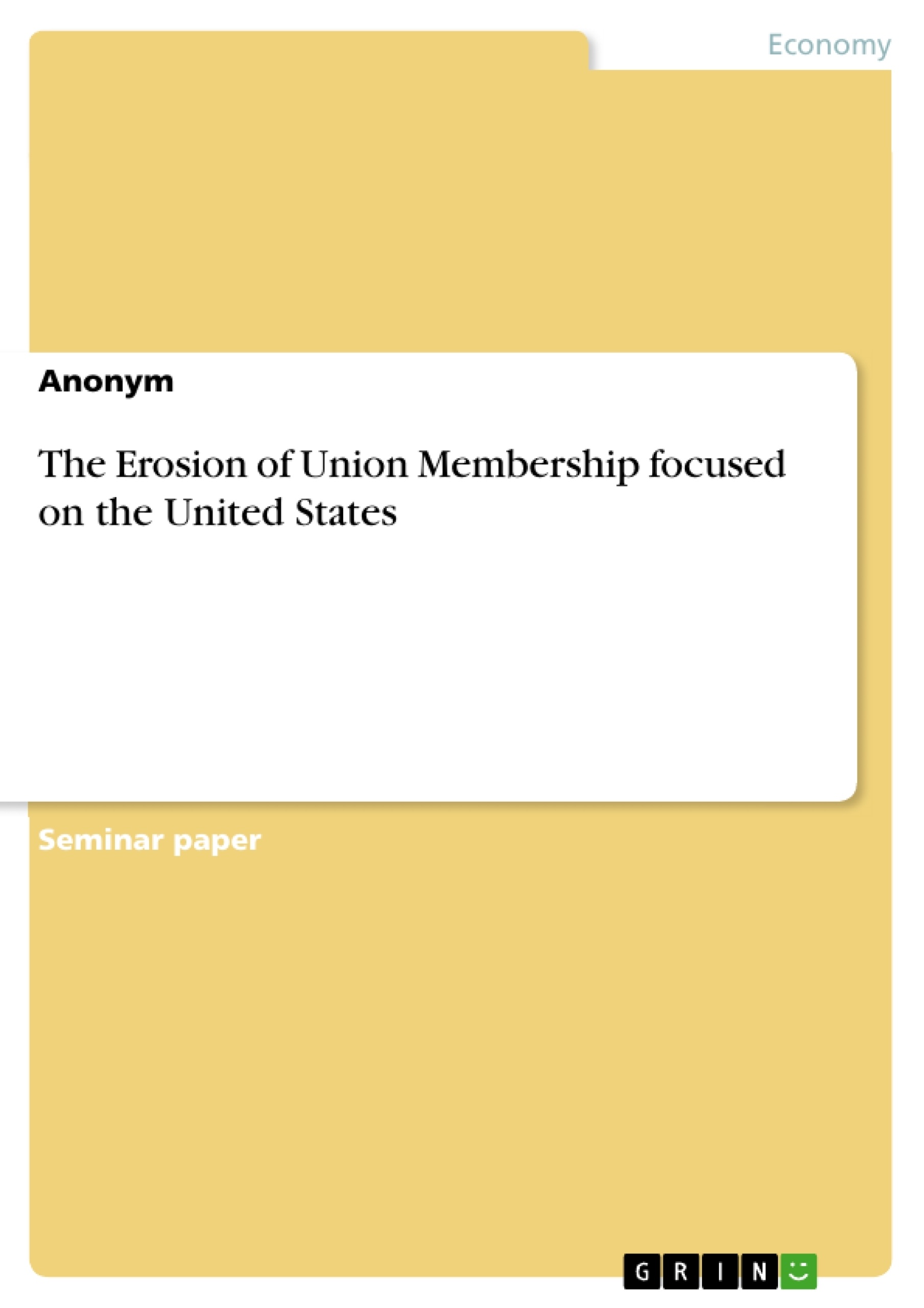Surveying some recent data and the empirical literature from various disciplines, this research paper attempts to shed some light on the topic ‘The Erosion of Union Membership in the United States’. Trade union membership density describes union membership as a percentage of all employees excluding the self-employed and represents a significant measurement for union success. Union density in the United States has declined significantly in recent decades.
The purpose of this research is to determine why such a decrease is occurring. There are several factors that contribute to this plunge in union membership density. In order to discover those it is essential to take a look at the history of the US labor union movement and some major factors and circumstances that posed an impediment to its progress as well as to examine the duties of unions and causes that impel employees to join unions. In conclusion the impact of plummeting union membership will be elucidated.
Inhaltsverzeichnis (Table of Contents)
- I. Introduction
- II. Development of unionism
- 1. Union movement in the United States
- 2. Comparison with European countries
- III. Duties of trade unions and their relation to employers.
- 1. Collective bargaining
- 2. Case of disagreement between union and employer.
- IV. Causes for joining trade unions
- 1. Collective bargaining.
- 2. Representation
- 3. Higher earnings
- 4. Health insurance premium
- 5. Retirement and paid leave
- V. Influences on union membership decline.
- 1. Structural changes
- a. Sectoral changes
- b. Gender-related changes
- c. Short-time employment.
- d. Regional employment changes.
- 2. Anti-union legislation and activities
- 3. Cyclical changes
- 1. Structural changes
- VI. Consequences.
Zielsetzung und Themenschwerpunkte (Objectives and Key Themes)
This research paper aims to investigate the declining union membership in the United States. By exploring historical developments, analyzing the factors influencing union membership, and examining the consequences of this decline, the paper seeks to shed light on the reasons behind this trend. Key themes covered in the text include:- Historical development of the US labor union movement
- Factors influencing union membership, including structural changes, anti-union legislation, and cyclical changes
- Duties of trade unions and their relationship with employers
- Causes for employees joining trade unions
- Consequences of declining union membership
Zusammenfassung der Kapitel (Chapter Summaries)
- Introduction: The paper introduces the topic of declining union membership in the United States, defines union membership density, and outlines the research objectives. It highlights the importance of understanding the historical context and the various factors contributing to this decline.
- Development of unionism: This chapter explores the history of the US labor union movement, starting with the early days of skilled craftsmen forming local unions in the 1790s. It discusses the legalization of trade unions, the impact of industrialization and the post-Civil War depression, and the emergence of major labor organizations such as the AFL and CIO. The chapter also compares the US labor movement to that of Great Britain, highlighting differences in worker motivation, workforce heterogeneity, and employer attitudes.
- Duties of trade unions and their relation to employers: This chapter delves into the roles and responsibilities of trade unions, focusing on collective bargaining, dispute resolution, and the relationship between unions and employers. It examines the process of negotiating agreements, the potential for disagreements, and the mechanisms for resolving conflicts.
- Causes for joining trade unions: This chapter outlines the various reasons why employees choose to join trade unions. It discusses the benefits of collective bargaining, representation, higher earnings, health insurance premiums, and retirement and paid leave. The chapter explores the perceived advantages of union membership and the factors that motivate employees to join.
- Influences on union membership decline: This chapter examines the factors contributing to the decline in union membership. It analyzes structural changes such as sectoral shifts, gender-related changes, short-time employment, and regional employment changes. Additionally, it explores the impact of anti-union legislation and activities, as well as cyclical changes in the economy.
Schlüsselwörter (Keywords)
The key focus of this research is the decline of union membership in the United States. The paper explores the historical development of the US labor union movement, analyzes the factors contributing to this decline, and examines the consequences of this trend. Key themes and concepts include trade union density, collective bargaining, anti-union legislation, structural changes, and the impact of declining union membership on the workforce and the economy.- Citar trabajo
- Anonym (Autor), 2016, The Erosion of Union Membership focused on the United States, Múnich, GRIN Verlag, https://www.grin.com/document/336846



